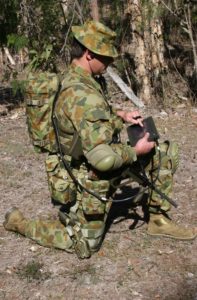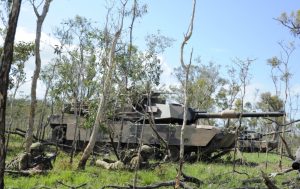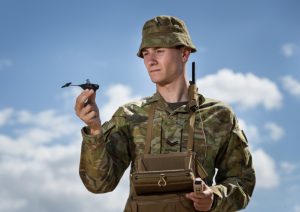This article is part 3 of a series of articles about the soldier combat system. In the first article, I examined the concept of the soldier as a system and discussed how to avoid the Christmas Tree effect. In the second article I discussed the integration of the soldier system with the human platform. This part will focus on the systems integration of equipment within the soldier system and with the remainder of the combined arms team. I’ll also look at some future integration issues with autonomous systems and manned-unmanned teaming.
Soldier System Integration
In Part 1 and 2, I described the Soldier System as all the elements that together allow an individual soldier to have an effect on the battlefield. Each piece of equipment that makes up the soldier system is required to integrate with the other equipment a soldier is carrying and with the soldier’s body.
In this article, I will further examine how we optimise the integration of the issued components of the soldier system with each other and with the other systems that make up the combined arms team. We will look at how it is has been done in the past, what is currently happening and what are some of the issues that will need to be considered in the future.
Examples of Integration in the Soldier System
Integration is the process by which all of the components and sub systems are brought together to function as a whole. The places where sub systems interact are called interfaces. Interfaces can be physical, functional, or require power and data compatibility. When integration is done well, the interfaces are efficient and the system itself is optimised.
A really simple example of integration in the Soldier Combat Ensemble (SCE) is the design of knee pads. Knee pads are important protective equipment to minimise injuries during activities like fire and movement. In the past, the issued knee pads were not comfortable and during movement, they did not stay on the knee. The current combat trousers now contain a pocket for the knee pad, which means it remains in place and is considerably more comfortable. The knee pad is integrated into the trousers instead of just being strapped onto the outside through a sub optimal interface.

A more complex example is the Battle Management System – Dismounted (BMS-D). BMS are designed to provide extra situational awareness to troops and commanders by passing messages, data and locations. This system required a series of extra components to be carried by a dismounted combatant in addition to their usual combat load. It had to physically integrate with the existing Load Carriage Equipment (LCE) and be interoperable with communications networks. The system created issues with size, weight, power and cables that ran through the soldier’s equipment. According to the Australian National Audit Office 'The user community do not accept and use the BMS-D'[1] The BMS-D was heavy and it did not integrate efficiently with other equipment. This is an example of integration done poorly, as a result the system is not in use and dismounted combatants have to rely on voice communications to share all information.
To fix this lack of situational awareness for dismounted soldiers, Project Land 200 will deliver an updated BMS-D that is lighter and has fewer cables. There are a number of technological advances that can contribute to optimising the integration between BMS-D and LCE. The RAAF’s Plan Jericho and Diggerworks are cooperating on a trial of a system that will examine the utility of integrating power and data access into the Australian Tiered Body Armour System (TBAS). This means that batteries do not need to be attached to each electronic item that a soldier carries, instead each item is connected directly into the TBAS vest which manages power and shares data between devices. The trial is necessary to determine how much weight, if any, is saved by employing technology in this way.
The Combined Arms Team as a System of Systems
When a soldier is fighting as part of a combined arms team they form part of a system of systems. A system of systems is when a collection of systems pool their resources and capabilities together to create a new, more complex system which offers more functionality and performance than simply the sum of the constituent systems. The soldier system should be able to integrate efficiently with the other systems that make up a combined arms team such as Armoured Fighting Vehicles (AFV), indirect fire support and aviation platforms.
If this level of integration is achieved, the combined arms team will be more effective in combat. A soldier will be able to mount as a passenger in a vehicle or helicopter and comfortably sit on their seat while still wearing Combat Body Armour and equipment. They will be able to connect to the AFV harness to recharge batteries, communicate using the vehicle’s greater power capabilities and access the vehicles situational awareness data network. A dismounted soldier who identifies a target will be able to press a button on their rifle and immediately communicate the enemy information to a supporting Main Battle Tank or Infantry Fighting Vehicle. That vehicle’s turret will automatically lay on to the target allowing the gunner to rapidly fire. Relying on voice communications to achieve these tasks is too slow and takes up vital time on combat radio nets. The information must be able to be passed accurately in near real time to ensure we have a decisive advantage in combat.

The scenario described above will only be achieved by smart procurement and development decisions. One part will be the employment of Weapon Integrated BMS (WINBMS). Another is the development of a generic architecture. A generic architecture is an open standard that mandates certain interfaces to support integration of sub systems. For example, the architecture may mandate a certain type of connector or power source to be used to as a standard throughout the Army. This would make it easier to integrate equipment, reduce crew and maintainer training burden and allow built in growth potential for adding future sub systems[2].
Currently The Australian Army have developed a Generic Vehicle Architecture (AS GVA) and are developing a Generic Soldier Architecture (AS GSA). When complete these projects will go some way to optimising the integration between the soldier system and the other systems that make up the combined arms team.
The Future of Systems Integration
In the near future the scenario above will involve the soldier system integrating not just with manned vehicle and aviation platforms, but also with unmanned systems using increasingly sophisticated and enabled robotics, artificial intelligence and machine learning. Due to our size relative to our potential adversaries, the Australian Army has a lot to gain from the use of autonomous systems[3], however because war is a human endeavour, the employment of these systems will never completely remove human soldiers from the battlefield[4]. The speed with which autonomous systems can make decisions and the capabilities they will bring to the battle make it absolutely vital that they integrate seamlessly with the soldier system.

The integration of human soldiers and robots or autonomous systems is generally referred to as Manned Unmanned Teaming (MUM-T). This concept is likely to affect all areas of the way a soldier fights in the near future, from load carriage to decision making. For example, the proliferation of unmanned systems with advanced sensors and communications equipment means that soldiers and commanders will have access to huge volumes of information. There is a risk that this will increase the cognitive burden to such an extent that soldiers experience decision paralysis and are actually disadvantaged by the huge amount of information they have access to[5]. Artificial Intelligence can contribute to solving this issue by sorting what is valuable information that is vital to the commander’s decision making and what is routine so can be discarded[6].
Conclusion
This article has provided an introduction to the concept of integration in the soldier system. I have examined where this has been done poorly in the past, described current efforts and identified opportunities for optimising integration into the future which will enhance the combat power of the combined arms team. Success in battle depends on our ability to apply lethal fires to the enemy before he does to us and the ability to do this depends on our soldiers’ ability to rapidly share information about the enemy with the entire team. This is achieved by efficient integration within the soldier system and by optimising the integration of the soldier with other platforms to form a system of systems.
Systems of systems and systems integration are naturally complex topics and in order to keep this article accessible I have not delved into too much detail. I welcome the ability to continue discussions about any aspects of the article in the comments section.









